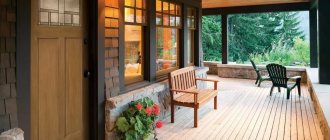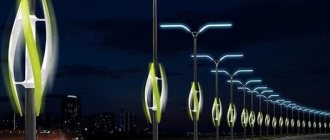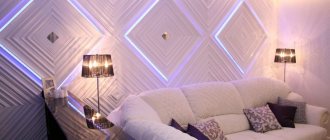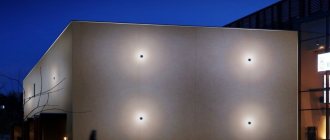Why light the terrace
Not all owners think about organizing lighting on the terrace during its construction. Then many people regret it, because lighting significantly expands the capabilities of the extension, adding the following features:
- With the onset of dusk, outdoor recreation does not end. Gatherings and late tea parties will be just as comfortable; nothing will stop you from reading a book or working on your laptop.
- If the terrace is adjacent to the entrance to the house, then its light plays an additional functional role, illuminating the porch and making it safe.
- Light becomes a design element, helping to create a festive or romantic atmosphere.
Patio lighting attracts insects, and this is its only significant drawback. The simplest solution is a mosquito net, but its installation may cause problems, and non-standard designs are too expensive.
Alternative devices help to cope with uninvited guests: repellers and insect destroyers.
Combined lighting Source pinimg.com
Why do you need terrace lighting?
Lighting the veranda at the dacha allows you to use it as a comfortable place to relax. Open terraces are often located on the street, and they require a special approach to lighting.
Advantages of backlight:
- comfortable rest in the evening;
- entrance door lighting for safe movement;
- giving the house an aesthetic appearance;
- use as decorative lighting;
- participation in the security system.
Before planning to equip small design forms, it is necessary to solve the main problem of installing lamps on a terrace or veranda. Lighting safety should come first. Terrace lighting is popular thanks to built-in LEDs. It can be installed anywhere.
Subtleties of lighting organization
The term terrace refers to several types of structures. Traditionally, it looks like an open area attached to the house, with or without a canopy, railings. Like the veranda, it can be a continuation of the entrance to the house, but the foundation is not laid under it. There is no glazing on the terrace; it can be built on any side of the house, but it is more practical to do it next to the porch, and in mid-latitude climates - from the southern facade.
The terrace can be attached or free-standing, but its area must be commensurate with the house, and its design must correspond to the design of the housing. In modern projects, the concept of a terrace has shifted. In some houses it is designed at the level of the second floor, or raised to the roof. It's not limited to a permanent canopy; Often the terrace is supplemented with glazing and heating.
Illumination of the canopy and steps Source goodeck.ru
For a standard terrace, lighting fixtures with a certain set of qualities are needed, suitable for outdoor lighting. The following requirements apply to their work:
- Reliability and security of devices. Stability of operation, protection from dust.
- Resistant to temperature and humidity fluctuations.
- Brightness level sufficient for a comfortable pastime.
- Appearance that matches the design of the house.
- Practicality and economy
Using directed sources Source archilovers.com
Rules for organizing the lighting of a veranda or terrace
Lighting a veranda is a difficult process that is carried out by planners, designers, and architects.
Before starting the lighting installation, carry out the following work:
- They inspect the room: in this case, determine the location of the cable to the electrical panel.
- Set the size of the veranda and the height of the ceiling.
- Determine the location of the suspended structure that affects the technological process of laying the cable.
- The thickness of the supporting structures is established, and the possibility of cutting them for cable laying is established.
The owner chooses the type of lighting:
- working;
- emergency;
- security;
- decorative;
- duty.
Working light covers the entire area of the veranda, intended for relaxation, people staying, and doing household work.
Emergency lighting is needed as a backup source when the central power supply is cut off.
Video cameras can be installed on the veranda territory. In this case, security lighting is used.
Decorative light is used to decorate the interior.
Duty - needs to be installed if it is necessary to highlight only the area of the porch or corridor.
Variety of lamps
Porch and patio lighting not only improves comfort, but also ensures safety. Therefore, general, functional lighting is complemented by lighting of railings, stairs and the perimeter of the site. The following types of lighting devices are used in lighting design:
- Wall lights. This is an affordable method if the terrace is adjacent to the wall of the house. The lamps are fixed in any suitable place, between windows or at the entrance. According to the design, lamps-sconces and shades are distinguished; Several sources will provide a sufficient level of illumination.
- Lanterns. They have a spectacular and varied appearance, so they can be used for terraces decorated in any style. They are secured to fence posts or railings (if any), or to an adjacent wall. Lights attached to the outside of the structure's supports can be supplemented with motion sensors; this will help reduce electricity consumption.
Street lamp on the attached terrace Source hzcdn.com
See also: Catalog of companies that specialize in electrical work of any complexity
- Illumination that is mounted into the finishing floor covering (terrace board). Spotlights are used for installation; they give the terrace an elegant and thoughtful look. Such lighting is not only beautiful, but also functional: it zones the space and outlines safe boundaries. Spotlights are often built into steps.
- The lighting in the terrace board is in harmony with the LED strip. It is fixed around the perimeter of the terrace, under the ceiling or in the handrails.
- For stairs, you can use the linear lighting technique, when a moisture-resistant LED strip is attached along the contour of the steps or along the edge of each step (protruding or recessed).
- The role of decorative or festive lighting on the veranda of a country house can be played by an LED strip or a garland of light bulbs, regular (incandescent) or LED retro lamps. Chinese lanterns look original and romantic.
The light of the garland is quite enough Source pinimg.com
- If the terrace is separate, it can be illuminated using tall street lamps placed in the corners of the site. Street lights are reliable in operation; You should choose models with a protection class of at least IP55. They can be supplemented with a garland or LED strip wound onto the railing.
- A technologically advanced and economically viable solution is to install solar-powered lamps on the open terrace. Their range is varied and affordable, and the luminosity reserve after a day's recharging is enough for several hours.
- A glazed and insulated veranda will be decorated with a chandelier or pendant lamps. The ceiling will look impeccable, complemented by point light sources.
Chandelier and pendant lamps Source paslaugos-img.dgn.lt
Options for lighting a veranda in a private house with photos
The main task of organizing lighting on verandas, gazebos and terraces is to create comfortable operation of these premises in conditions of poor visibility. The main elements of such buildings: stairs, railings, perimeter boundaries, require illumination most of all, because ensuring safety is the primary function of light.
Many stylistic methods can be used to decorate the lighting of stairs and railings:
1. Linear or accompanying lighting of the veranda with LED strips is a real hit not only this season, but the past and the coming season.
In addition to ease of installation, economical operation and minimal costs for purchasing such a lighting system, LED strips are characterized by tightness and durability.
By the way, how to make shelf lighting with LED strip in our useful article with a master class.
This allows you to use such lamps even on an open veranda. In addition, with such tapes you can easily create uninterrupted lighting from a power source.
2. For linear illumination of steps, you can use the accompanying installation method, that is, attaching the tape along the entire length of the flight of stairs in a straight line or along the contour of the steps.
3. The staircase lighting, horizontal along the protruding or, conversely, recessed edge of the step, also looks very nice.
4. Often such lighting is mounted hidden in profiles along with accompanying lighting in railings and balustrades.
5. Spot and linear lighting will look no less colorful, where sources of diffused light are installed in the floor, in the risers, on the surface of the tread, at the end of the step or in the string along the line of the steps.
6. Installing small halogen lamps in balusters, railings and around the perimeter of the room can not only visually give an outline to the room in the dark, but also fill it with a soft, cozy light.
How to properly make staircase lighting - all the details and step-by-step instructions.
The choice of lamps for the veranda can be based both on the general concept of the interior design of the house, and in the same style with the landscape design, if we are talking about the building as a separate architectural object. In addition, the lighting design of a summer terrace can be absolutely unique, the main thing is that its overall appearance fits harmoniously into the overall appearance of the site. Today, such a task is easily solvable for modern designers, because with the right approach you can skillfully combine classics with futurism, modernity with baroque, grunge with country.
How to choose a lamp
Lamps are selected based on a combination of characteristics. For outdoor appliances, not only their tightness and design are important, but also the material from which the housing is made, service life and efficiency. Many parameters depend on which light bulb is inside, so when evaluating options, they are compared. The choice of lamps is influenced by the minimum service life, cost, power and color spectrum of radiation.
Incandescent lamps
Traditional filament devices are always popular. Their main advantages are budget and accessibility. Incandescent lamps emit light in the warm part of the spectrum, which makes the environment more cozy. As a plus, you can add a variety of models and characteristics.
There are also a lot of disadvantages: low efficiency (most of the energy goes into heat, not light) and a short lifespan, not exceeding 1-1.5 thousand hours. During operation, the bulb of a 100-watt lamp heats up to 290°. This is a significant disadvantage from a fire safety point of view for lighting on a veranda in a wooden house.
Design of a small terrace Source hzcdn.com
Lighting in design
Lighting on the terrace can be arranged in different ways. The following techniques will help you create practical and at the same time stylish lighting:
- Illumination above the entrance or on the sides of it. Floor lamps of any shape and size, or wall models are suitable; the main thing is that they correspond to the general style. If there is a canopy, the lamps can be replaced with a garland. Warm shades of yellow and orange will fit into traditional design (country, retro), pale pink, lilac or purple light will highlight modern design.
- Lamps are chosen according to style. Forged and wooden models will fit into the traditional design; models made of metal and tinted glass will be at home in a modern environment.
Jacuzzi on the terrace Source interiordesign.io
- The corners of the terrace can be illuminated with large floor lamps, this will effectively mark the boundaries of the recreation area.
- Illuminating plants looks stylish, especially if the terrace is surrounded by a vertical garden or high views. Point sources are suitable for illumination; you can use a neon line.
- A living flame will organically blend into the overall picture. Its source can be a fireplace or a module built into the terrace (a fresh idea for organizing a fire). If a live flame seems like a dangerous idea, it can be replaced with a glowing panel on the wall.
With plant lighting Source pinimg.com
Briefly about the main thing
Lighting a terrace is a creative task that can be implemented in different ways. What the lighting will be like depends on the location of the structure, its size, and whether it is open or glazed.
For an open terrace, safe operation of light sources is important; their significant characteristic is resistance to fluctuations in humidity and temperature. Equally important are the cost-effectiveness, service life and color of light emission.
Thanks to the variety of models, lighting design in any style is possible. The lamps are fixed at different points on the terrace, mounted in the floor, and illuminate the plants and the outline of the building.
Ratings 0











